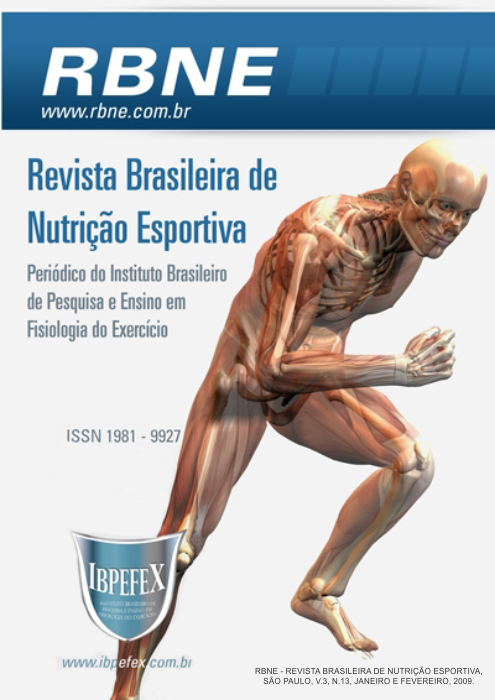Strategies and methods used for pre-competition weight loss in boxers
Abstract
This study aimed to investigate the methods and strategies used by boxers to reduce weight on the eve of competitions, analyzing the possible influences on performance and subjectively considering psychological and physiological aspects. In this survey 14 male fighters at the average age of 27.9 ± 4.9, who have been training for 11 ± 4.9 years, competing for 6.5 ± 3.9 years, with a frequency of 9.75 ± 2.06 competitions a year, were interviewed. The results show that the majority (64%)uses methods to help fast weight loss. Reported methods: some athletes work harder in training (50%), others wear warm clothing during training period (7%), and others (30%) reported doing aerobic exercises. From the analyzed data, it appears that the pre-competition weight loss is a reality in boxing and Brazilian athletes regard it as is a benefiting strategy. We have seen that each athlete seeks the weight loss method that best fits. According to the consulted literature, the weight loss may really occur and if it is well controlled, the performance and health of the athlete can be preserved, but in some cases performance may be hampered because of the magnitude of weight loss, as well as the strategy used. We conclude that the athletes lose much weight in a few days before the competitions and they use the methods of weight loss several times a year, and this could undermine athletic performance and health of the fighter.
References
American College of Sports Medicine. Programas Apropriados e Impróprios para Perda de Peso. Apêndice 13 pág 630-634.
ACSM. Perda de Peso em Lutadores. In: Mcardle, W. D., Katch, F. I., Katch, V. L. Nutrição para o desporto e o exercício. Guanabara Koogan, 2001. pág 616-618.
Artioli, G.G.; Franchini, E.; Junior, A.H.L. Perda de Peso em Esportes de Combate de Domínio: Revisão e Recomendações aplicadas. Revista Brasileira de Cineantropometria & Desempenho Humano. V.8, n.2, pg 92-101, 2006.
Bacurau, R.F. Nutrição e suplementação esportiva. Phorte Editora, 3 ed, 2005.
Bompa, T.O. Periodização: teoria e metodologia do treinamento. 4ª ed., São Paulo, Ed. Phorte, 2002.
Costa, L.O.P.; Samulki, D.M. Overtraining em atleta de alto nível – uma revisão literária. Revista Brasileira e Ciência e Movimento. 13(2) pg. 123-134, 2005.
Foss, M.L.; Keteyian, S.J. Bases Fisiológicas do Exercício e do Esporte. Ed. Guanabara Koogan, Rio de Janeiro, 2000.
Hirschbruch, M.D.; Carvalho, J.R. Nutrição Esportiva, Editora Manole, Tamboré Barueri SP, 2002.
Ide, B.N. Considerações sobre a redução da massa corporal antes das competições nas modalidades desportivas de luta. http://www.efdesportes.com Revista Digital; 10 (75), 2004.
Kininglam, R.B.; Gorenflo, D,W. Weight loss methods of high shool wrestlers. Med Sci Sport Exerc; 33(5): 810-813; 2001.
Mcardle, W.D.; Katch, F.I.; Katch, V.L. Nutrição para o desporto e o exercício. Guanabara Koogan, 2001.
Malheiro, A.S.; Gouveia, M.J. Ansiedade física social e comportamentos alimentares de risco em contexto desportivo. Análise Psicológica (2001). 1 (XIX): 143-155.
Silva, C.M. Perturbações alimentares em contextos desportivos: Um estudo comparativo. Analise Psicológica 2001, 1 (XIX): 131-141
Verkhoshanski, Y.V. Preparação de força especial. Rio de Janeiro, ed. Grupo Palestra Sport, 1995.
Zatziorsky, V.M.; Ciência e prática do treinamento de força. São Paulo, SP: Phorte Editora, 1999. 315p.
Authors who publish in this journal agree to the following terms:
- Authors retain the copyright and grant the journal the right of first publication, with work simultaneously licensed under the Creative Commons Attribution License BY-NC which allows the sharing of the work with acknowledgment of the authorship of the work and initial publication in this journal.
- Authors are authorized to enter into additional contracts separately for non-exclusive distribution of the version of the work published in this journal (eg, publishing in institutional repository or book chapter), with acknowledgment of authorship and initial publication in this journal.
- Authors are allowed and encouraged to post and distribute their work online (eg, in institutional repositories or on their personal page) at any point before or during the editorial process, as this can bring about productive change as well as increase impact and impact. citation of published work (See The Effect of Free Access).






